![]()
Aroids and other genera in the Collection
Take the Tour Now?
Orchids
The
Exotic Rainforest
Plants in
the Exotic Rainforest Collection
Images on this website are copyright protected. Contact
us before attempting to reuse.
In depth information on how to grow Philodendron species, Click this Link
Within our collection we have many species of Philodendron.
If you are seeking other photos,
click this link
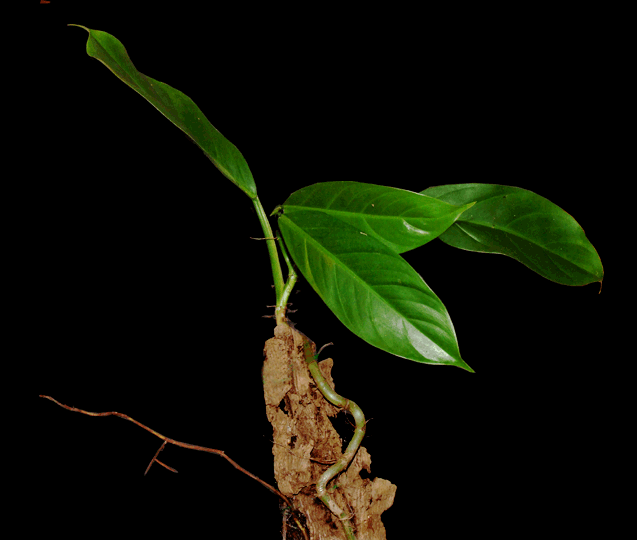
All the photos on this page of
Philodendron heterocraspedum are of a sub-adult specimen which has yet to produce an inflorescence. The inflorescence of Philodendron heterocraspedum is described in this article.
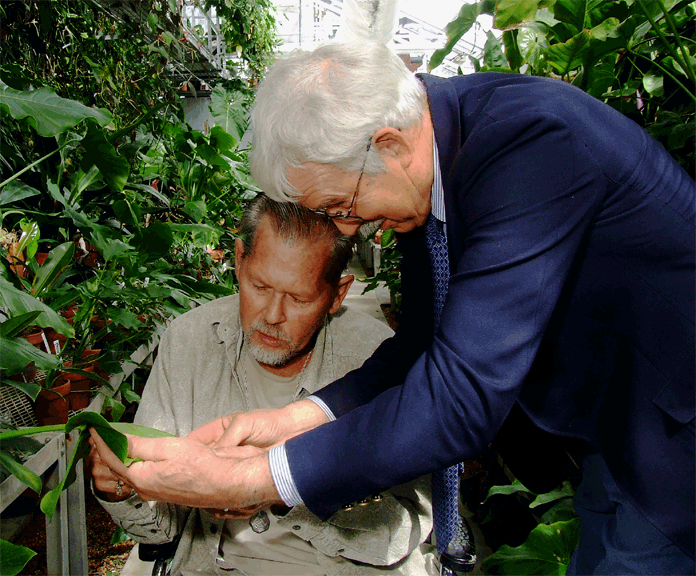 Based
on the field notes published on TROPICOS
(a service of the Missouri Botanical Garden) of aroid botanist Dr.
Thomas B. Croat Ph.D., P.A. Schulze Curator of Botany of the Missouri
Botanical Garden in St. Louis (photo right),
Philodendron heterocraspedum grows as both an appressed
epiphyte (ep-a-FIT) growing close to the host and a terrestrial species.
Philodendron heterocraspedum was discovered in Colombia in the
Valle del Cauca Vicinity Bajo Calima. An epiphytic species is one that
grows attached to another plant, normally a tree. Philodendron
heterocraspedum has also been observed growing on steep banks and
as a hemiepiphytic vine. A hemiepiphyte (hem-a-EPA-fit) is a plant that often begins
life as a seed that has fallen to the ground and finds a host tree to
climb while an epiphyte begins life as a seed placed on the tree in the
droppings of a rain forest bird or animal that has eaten the fruit of
the inflorescence.
Based
on the field notes published on TROPICOS
(a service of the Missouri Botanical Garden) of aroid botanist Dr.
Thomas B. Croat Ph.D., P.A. Schulze Curator of Botany of the Missouri
Botanical Garden in St. Louis (photo right),
Philodendron heterocraspedum grows as both an appressed
epiphyte (ep-a-FIT) growing close to the host and a terrestrial species.
Philodendron heterocraspedum was discovered in Colombia in the
Valle del Cauca Vicinity Bajo Calima. An epiphytic species is one that
grows attached to another plant, normally a tree. Philodendron
heterocraspedum has also been observed growing on steep banks and
as a hemiepiphytic vine. A hemiepiphyte (hem-a-EPA-fit) is a plant that often begins
life as a seed that has fallen to the ground and finds a host tree to
climb while an epiphyte begins life as a seed placed on the tree in the
droppings of a rain forest bird or animal that has eaten the fruit of
the inflorescence.
The
leaf blades of Philodendron heterocraspedum are sub-coriaceous
(less than leathery to the touch) and either semi-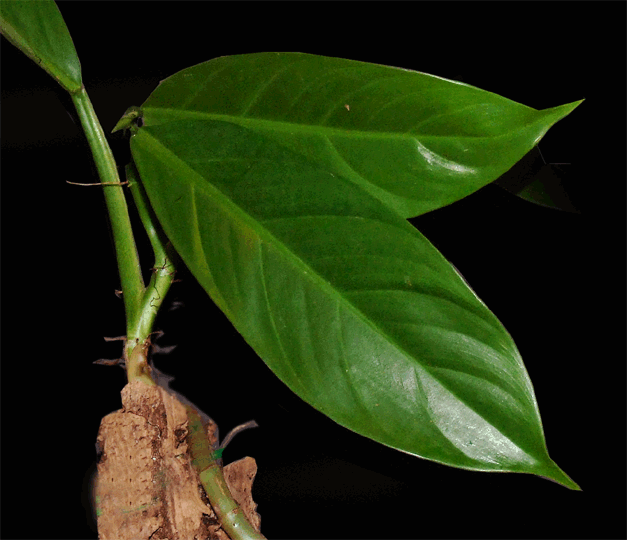 glossy or
slightly matte on the adaxial (upper) leaf surface but substantially paler
and semi-glossy abaxially (beneath)(see photo at the bottom of this article). The primary lateral veins are slightly sunken on
the upper leaf surface and raised beneath. The blades are semi-glossy
but may also be bi-colorous and often possess a white ridge.
glossy or
slightly matte on the adaxial (upper) leaf surface but substantially paler
and semi-glossy abaxially (beneath)(see photo at the bottom of this article). The primary lateral veins are slightly sunken on
the upper leaf surface and raised beneath. The blades are semi-glossy
but may also be bi-colorous and often possess a white ridge.
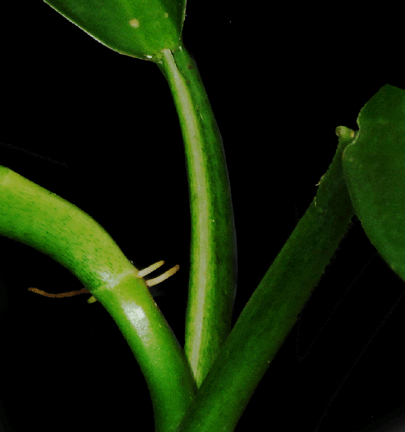 The
petioles which support each leaf blade of Philodendron
heterocraspedum are sharply C-shaped (sometimes almost D shaped)
when seen cut as a cross section. The C indention in the petiole
can be seen in the photo (right). The petiole is also sulcate.
Sulcate
indicates either a canal known as a sulcus or having numerous fine parallel
grooves.
The petiole is also striated (see photo, below left).
The
petioles which support each leaf blade of Philodendron
heterocraspedum are sharply C-shaped (sometimes almost D shaped)
when seen cut as a cross section. The C indention in the petiole
can be seen in the photo (right). The petiole is also sulcate.
Sulcate
indicates either a canal known as a sulcus or having numerous fine parallel
grooves.
The petiole is also striated (see photo, below left).
The cataphylls, which are a bract-like modified leaf that surrounds every newly emerging leaf blade, are medium green tinged slightly red and persist intact (but may also be deciduous) once the new leaf emerges. Deciduous means the cataphyll falls from the plant. The cataphyll of Philodendron heterocraspedum is sharply single edged and may have a second ridge near the apex (top) causing it to be D-shaped.
Philodendron species are aroids, a plant that reproduces via an
inflorescence known to science as a spathe and spadix.
Although most believe the spathe is a "flower", it is not. The spathe is
another
modified leaf
appearing to be a hood whose purpose is to protect the spadix.
The spadix is a spike on a thickened fleshy axis which can produce tiny
flowers. Once
ready to be pollinated (anthesis) tiny flowers can be found along the
spadix. Those flowers on the
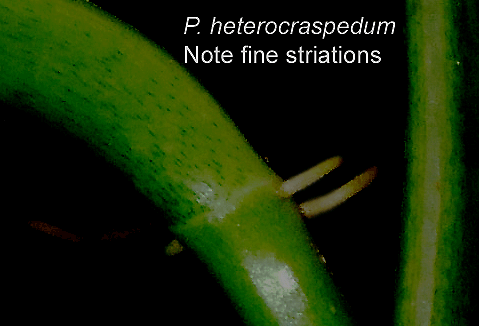 spadix
are male, female and sterile which if
pollinated by an appropriate insect, normally a beetle, will produce
berries containing seeds
spadix
are male, female and sterile which if
pollinated by an appropriate insect, normally a beetle, will produce
berries containing seeds
The inflorescences of Philodendron heterocraspedum are at least paired but there may be as many as 5 inflorescences per axil. The spathe is a greenish white on the outside and is pale green on the inside with the exception of the red/violet (magenta) at the base of the spathe tube. During female anthesis the spathe tube may be a pale green. The spadix is white and is tapered to narrowly pointed. The peduncle which supports each inflorescence is short (less than 5cm) and medium green. To date, we have not observed an inflorescence on this species.
Aroids are known to produce variable leaf blades as a result of ontogeny. commonly known as morphogenesis. Variation within species does not always require the plant to present the same leaf shape. The following link explains in non-technical language natural variation and morphogenesis within both aroids and other plant species. Click here.
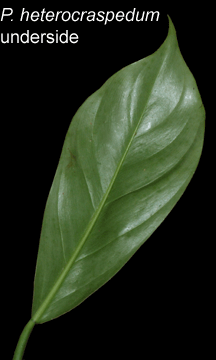
If you are seeking information on other rare species, click on "Aroids and other genera in the Collection" at the top and look for the
Want to learn more
about aroids?
Join the
International Aroid Society:
http://www.exoticrainforest.com/Join%20IAS.html